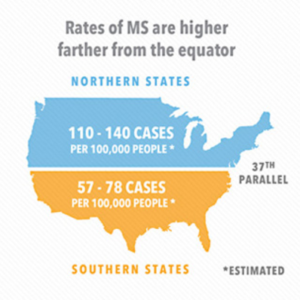Multiple sclerosis (MS) is a disease of the central nervous system that affects the brain and spinal cord. An estimated 400,000 suffer from multiple sclerosis in the US, with 2.5 million affected worldwide.
It is most prevalent in women between 20 and 40 years old.
MS is a debilitating and progressive disease that causes the immune system to attack the neuron’s myelin sheath, a protective membrane that is essential for the proper functioning of the nervous system. MS decreases the central nervous system’s (CNS) ability to communicate with other parts of the body.
 Symptoms of MS include numbness and tingling, sensory and vision problems, tremors, gait and balance issues, dizziness, and fatigue. Left untreated, multiple sclerosis can lead to complications such as paralysis, epilepsy, and mental and emotional changes.
Symptoms of MS include numbness and tingling, sensory and vision problems, tremors, gait and balance issues, dizziness, and fatigue. Left untreated, multiple sclerosis can lead to complications such as paralysis, epilepsy, and mental and emotional changes.
MS has no known cure. Although medications are used to slow the progression and control the symptoms of the disease, the side effects are troublesome. In recent years, many MS patients have started turning to cannabis to treat their symptoms.
Understanding Multiple Sclerosis
When an individual has multiple sclerosis, their immune system targets the myelin sheath of the brain and spinal cord. Essentially, MS tricks the immune system into thinking that the myelin sheath is an antigen (a toxic or foreign substance). The exact reasons for this are unknown, but certain factors are suspected.
Multiple sclerosis is not a hereditary disease, but genetics can be a factor. If one of your parents or siblings has multiple sclerosis, the chance of developing MS increases. People suffering from other autoimmune diseases are also at higher risk of developing multiple sclerosis. Certain infections may contribute to MS, especially those causing damage to the myelin sheath, like Epstein-Barr or measles.
Pathophysiology of Multiple Sclerosis
Neurons, or nerve cells, have a body, dendrites, and an axon. The body houses the nucleus, while the dendrites branch out to receive electrical signals from other neurons. The axon, like a long antenna, extends out from the neuron body to transmit electrical signals. Axon terminals, located at the end of the axon, release neurotransmitters between the neurons before they bind with the axons and dendrites of other neurons.
Even before birth, the axon is covered by the myelin sheath, which is produced by specialized cells in the central and peripheral nervous systems. The sheath protects and insulates the axon, and provides faster transmissions from one neuron to another.
Two theories exist as to how MS begins, both involving the blood-brain barrier which prevents pathogens and other antigens from entering the nervous system.
One theory states that external factors weaken the blood-brain barrier, enabling the pathogen to attack the CNS. Another theory suggests that defective neurons cause the immune system to attack the myelin sheath.
Deterioration of the blood-brain barrier with an abnormal inflammatory response is one of the first steps in developing multiple sclerosis1. As a trigger induces a proinflammatory response, this increases certain types of cells that release harmful molecules, which in turn cause tissue damage and inflammation in the brain. As the cells proliferate, they destroy the sheath and damage the blood-brain barrier leading to a plaque buildup throughout different parts of the brain and spinal cord.
As MS progresses, a loss of myelin sheath, axonal damage and atrophy2, dendritic atrophy, and neuronal loss affect signal transmission and cause long-term debilitation.
Current Treatments for Multiple Sclerosis
As mentioned previously, MS has no known cure. Although medications may reduce progression and prevent relapses of multiple sclerosis by suppressing the immune system, no drug can stop the immune system from attacking the myelin sheath or reverse the damage. Treatment for MS symptoms include antidepressants, anxiolytics, and muscle relaxants.
Medications may be helpful in managing MS, but come with side effects including:

- Flu-like symptoms
- Gastrointestinal problems
- Nausea and vomiting
- Back pain
- Allergic reactions
Long-term complications include:
- Liver problems
- Immune system problems
- Mood changes
- Irregularity and changes in menstrual periods
- Hair loss
- Nerve damage
- Birth Defects
- Multifocal leukoencephalopathy, a fatal brain infection
Cannabis: An Alternative Treatment for Multiple Sclerosis
The hallmark of multiple sclerosis3 is the loss of myelin and the formation of plaque in multiple areas of the brain and spinal cord, causing an autoimmune response that results in impaired signal transmission between neurons and subsequent motor, sensory, and mental difficulties.
Despite the debilitating and progressive nature of this disease, many successful stories, studies, and trials have proven that cannabis can be very beneficial to people suffering from multiple sclerosis.
Cannabinoids are Effective at Inhibiting Inflammation
The attack on axonal myelin caused by multiple sclerosis causes significant inflammation. During this process cytokines are released, which recruit additional immune cells and increase the severity of the inflammation; all while other destructive changes cause oxidative stress in cells and, ultimately, apoptosis (cell death).
Increased cytokines prevent reabsorption of neurotransmitters like glutamate which play a role in multiple sclerosis4. Elevated levels of glutamate over-stimulate receptors, leading to excitotoxicity, neuron degeneration, and apoptosis, worsening multiple sclerosis symptoms and causing long-term disability.
Phytocannabinoids inhibit inflammation in several different ways:
- Tetrahydrocannabinol, THC, produces anti-inflammatory effects by activating the ECS’ CB1 receptors5. When CB1 receptors are activated, the hypothalamus releases hormones regulating the immune system.
- THC also kills proinflammatory cells by activating their caspase6. Caspases are enzymes which prompt the start of apoptosis.
Cannabidiol (CBD) has anti-inflammatory properties without the psychoactive effects of THC. In one study, CBD-induced apoptosis of T-cells7 by increasing caspase activity, thereby inhibiting the inflammatory process.
Other ways CBD helps reduce inflammation:
- CBD inhibits the production of Tumor Necrosis Factor (TNF)8, which plays a role in inflammation as one of the first cell signaling proteins in the process’ acute phase. In multiple sclerosis, TNF contributes to the worsening of MS by destroying the glial cells9 producing myelin.
- CBD suppresses the function of certain white blood cells10 which secrete antibodies. In multiple sclerosis, these antibodies destroy the myelin sheath11 and activate other cells, making inflammation more severe.
Cannabinoids are Effective in Reducing Spasticity
Commonly associated with multiple sclerosis, spasticity affects about 80% of MS patients. Anandamide, an endocannabinoid produced by the body, controls spasticity by activating CB1 receptors and suppressing the release of glutamate and other neurotransmitters which inhibit GABA, an inhibitory neurotransmitter.
THC and CBD also have antispasmodic effects. THC activates CB1 receptors12 to produce their antispasmodic effects. However, activating CB1 receptors may produce psychoactive effects.
CBD has little affinity with CB1 receptors, but as an uptake inhibitor, it enhances the level of anandamide13. By slowing the breakdown of anandamide, CBD prevents it from reacting with the enzyme responsible for anandamide degradation by competing with endocannabinoids14 and binding with available proteins. This action allows more anandamide to activate CB1 receptors, producing their antispasmodic effects.
THC and CBD work well together to reduce spasticity in multiple sclerosis as proven by a human clinical study using THC-CBD oral spray15. While THC activates CB1 receptors to reduce spasticity, CBD reduces the psychoactive effects of THC in two ways – first by activating the allosteric sites of CB116, changing its size and preventing THC from binding with it, and secondly by binding with the enzymes17 responsible for breaking down THC. In the study, 70.5% of more than 1600 participants with multiple sclerosis reported significant improvement in spasticity. The study concluded that a THC-CBD combination is safe for consumption and an efficacious treatment of moderate to severe spasticity, especially for those resistant to traditional therapy.
Cannabinoids are Effective at Controlling Neuropathic Pain

Talk show host and MS sufferer, Montel Williams
Neuropathic pain, a chronic and intractable pain which is unresponsive to regular pain medications, is almost always present in multiple sclerosis patients because the nerves themselves are damaged.
Factors contributing to neuropathic pain18:
- High levels of glutamate and overactivation of their receptors
- Glutamate releases a neuropeptide responsible for the perception of pain.
- Brain-derived neurotrophic factors enhance pain perception by making the pain pathways more sensitive.
- Inflammation causes central sensitization.
THC and CBD both reduce neuropathic pain19:
- Both suppress the release of glutamate
- THC reduces sensitivity to pain by activating CB1 receptors, which modulate pain perception. CBD reduces pain by stimulating two different receptors which are also linked to pain perception.
- Both reduce inflammation by inducing apoptosis of proinflammatory cells, stimulating CB1 receptors, and activating CB2 receptors of the immune cells.
Cannabinoids are Effective at Reducing Excitotoxicity
Excitotoxicity20 wreaks havoc by destroying neurons and myelin-producing cells. Excitotoxicity occurs when excessive substances, such as glutamate, overstimulate neurotransmitters, ultimately leading to damage and death of nerve cells.
CBD has neuroprotective properties21, suppressing the inflammatory process and inhibiting cytokine production, inhibiting the release of glutamate, and decreasing oxidative stress. Through these functions, CBD improves brain metabolic activity, resulting in enhanced motor and cognitive performance22.
Oxidation is a chemical reaction in which molecules lose their electrons and create free radicals, damaging the components of the cell and prompting a negative chain reaction. Cannabinoids are potent antioxidants23 which counteract the effects of oxidation and excitotoxicity.
Other Effects of Cannabinoids
THC and CBD address other symptoms associated with multiple sclerosis:
- Reducing gastrointestinal inflammation24 and diarrhea symptoms in some patients with multiple sclerosis.
- Helping control anxiety25 and depression26 in patients suffering from MS.
Studies on Cannabinoids as a Treatment for Multiple Sclerosis
Many clinical trials have proven that CBD and THC are effective in treating multiple sclerosis.
- A study was conducted with 37 adult multiple sclerosis participants experiencing spasticity. The participants were divided into two groups – one group smoked cannabis while the other group smoked placebo cigarettes. After the initial treatment period, the treatments were reversed. Assessment results revealed a significant reduction in pain and spasticity27.
- Twenty MS patients, with half reporting neuropathic pain, participated in another study using Sativex. After just one month of using the cannabis spray, participants reported significant symptom improvement28, and those with neuropathic pain also reported quality of life improvements.
- Another study divided 66 multiple sclerosis patients with central neuropathic pain into two groups – one receiving Sativex, the other a placebo. Participants used as much or as little as they needed through the two-year trial. Assessments before, during, and after the trial proved Sativex is effective in improving multiple sclerosis symptoms29. Only mild to moderate side effects were reported.
- 322 patients with spastic multiple sclerosis who participated in a three-month study reported significant improvement in spasticity30 after Sativex treatments. Only 41 participants (13.1%) reported mild side effects such as dizziness, nausea, and drowsiness.
Numerous studies have proven cannabinoids help patients with multiple sclerosis. Cannabinoids like THC and CBD work together to produce impressive medicinal effects, often addressing symptoms of multiple sclerosis with minimal side effects.
References:
1 Christopher Luzzio, MD, et al. March 1, 2017.
MedScape, Multiple Sclerosis.
http://emedicine.medscape.com/article/1146199-overview Accessed: April 6, 2017.
2 Jeffrey D. Haines, et al. March 1, 2012.
The National Center for Biotechnology Information, Axonal Damage in Multiple Sclerosis.
https://www.ncbi.nlm.nih.gov/pmc/articles/PMC3142952/ Accessed: April 6, 2017.
3 Bogdan F. Gh. Popescu, MD, PhD, et al. August 2013.
The National Center for Biotechnology Information, Pathology of Multiple Sclerosis: Where Do We Stand?
https://www.ncbi.nlm.nih.gov/pmc/articles/PMC3915566/ Accessed: April 6, 2017.
4 IR Stojanovic, et al. March 15, 2014.
The National Center for Biotechnology Information, The role of glutamate and its receptors in multiple sclerosis.
https://www.ncbi.nlm.nih.gov/pubmed/24633998 Accessed: April 6, 2017.
5 D Baker, et al. September 24, 2007.
The National Center for Biotechnology Information, Cannabinoid control of neuroinflammation related to multiple sclerosis.
https://www.ncbi.nlm.nih.gov/pmc/articles/PMC2190016/ Accessed: April 6, 2017.
6 Prakash Nagarkatti, et al. August 1, 2010.
The National Center for Biotechnology Information, Cannabinoids as novel anti-inflammatory drugs.
https://www.ncbi.nlm.nih.gov/pmc/articles/PMC2828614/ Accessed: April 6, 2017.
7 CY Lee, et al. February 14, 2008
The National Center for Biotechnology Information, A comparative study on cannabidiol-induced apoptosis in murine thymocytes and EL-4 thymoma cells.
https://www.ncbi.nlm.nih.gov/pubmed/18387516 Accessed: April 12, 2017.
8 AM Malfait, et al. August 15, 2000.
The National Center for Biotechnology Information, The nonpsychoactive cannabis constituent cannabidiol is an oral anti-arthritic therapeutic in murine collagen-induced arthritis.
https://www.ncbi.nlm.nih.gov/pubmed/10920191 Accessed: April 12, 2017.
9 The National Center for Biotechnology Information, TNF
neutralization in MS: results of a randomized, placebo-controlled multicenter study. The Lenercept Multiple Sclerosis Study Group and The University of British Columbia MS/MRI Analysis Group.
https://www.ncbi.nlm.nih.gov/pubmed/10449104 Accessed: April 12, 2017.
10 Ewa Kozela, et al. March 15, 2015.
The National Center for Biotechnology Information, Cannabidiol, a non-psychoactive cannabinoid, leads to EGR2-dependent anergy in activated encephalitogenic T cells.
https://www.ncbi.nlm.nih.gov/pmc/articles/PMC4363052/ Accessed: April 12, 2017.
11 Klaus Lehmann-Horn, et al. May 2013.
The National Center for Biotechnology Information, Targeting B cells in the treatment of multiple sclerosis: recent advances and remaining challenges.
https://www.ncbi.nlm.nih.gov/pmc/articles/PMC3625013/ Accessed: April 12, 2017.
12 G Pryce and D Baker. January 15, 2007.
The National Center for Biotechnology Information, Control of Spasticity in a Multiple Sclerosis Model is mediated by CB1, not CB2, Cannabinoid Receptors.
https://www.ncbi.nlm.nih.gov/pmc/articles/PMC2189718/ Accessed: April 12, 2017.
13 Uwe K. Zettl, et al. January 2016.
The National Center for Biotechnology Information, Evidence for the efficacy and effectiveness of THC-CBD oromucosal spray in symptom management of patients with spasticity due to multiple sclerosis.
https://www.ncbi.nlm.nih.gov/pmc/articles/PMC4710104/ Accessed: April 12, 2017.
14 Matthew W. Elmes, et al. February 9, 2015.
The National Center for Biotechnology Information, Fatty Acid-binding Proteins (FABPs) Are Intracellular Carriers for Δ9-Tetrahydrocannabinol (THC) and Cannabidiol (CBD).
https://www.ncbi.nlm.nih.gov/pmc/articles/PMC4423662/ Accessed: April 12, 2017.
15 F Patif, et al. May 9, 2016.
The National Center for Biotechnology Information, Efficacy and safety of cannabinoid oromucosal spray for multiple sclerosis spasticity.
https://www.ncbi.nlm.nih.gov/pubmed/27160523 Accessed: April 12, 2017.
16 RB Laprairie, et al. October 2015.
The National Center for Biotechnology Information, Cannabidiol is a negative allosteric modulator of the cannabinoid CB1 receptor.
https://www.ncbi.nlm.nih.gov/pmc/articles/PMC4621983/ Accessed: April 12, 2017.
17 LM Bornheim, et al. March 24, 1993.
The National Center for Biotechnology Information, Characterization of cannabidiol-mediated cytochrome P450 inactivation.
https://www.ncbi.nlm.nih.gov/pubmed/8466552 Accessed: April 12, 2017.
18 Alban Latremoliere and Clifford J. Woolf. September 1, 2010.
The National Center for Biotechnology Information, Central Sensitization: A Generator of Pain Hypersensitivity by Central Neural Plasticity
https://www.ncbi.nlm.nih.gov/pmc/articles/PMC2750819/ Accessed: April 12, 2017.
19 Ethan B Russo. February 2008.
The National Center for Biotechnology Information, Cannabinoids in the management of difficult to treat pain.
https://www.ncbi.nlm.nih.gov/pmc/articles/PMC2503660/ Accessed: April 12, 2017.
20 D Pitt, et al. January 2000.
The National Center for Biotechnology Information, Glutamate excitotoxicity in a model of multiple sclerosis.
https://www.ncbi.nlm.nih.gov/pubmed/10613826 Accessed: April 12, 2017.
21 MR Pazos, et al.
The National Center for Biotechnology Information, Mechanisms of cannabidiol neuroprotection in hypoxic-ischemic newborn pigs: role of 5HT(1A) and CB2 receptors.
https://www.ncbi.nlm.nih.gov/pubmed/23587650 Accessed: April 12, 2017.
22 Orrin Devinsky, et al. May 22, 2014.
The National Center for Biotechnology Information, Cannabidiol: Pharmacology and potential therapeutic role in epilepsy and other neuropsychiatric disorders.
https://www.ncbi.nlm.nih.gov/pmc/articles/PMC4707667/ Accessed: April 12, 2017.
23 AJ Hampson, et al. July 7, 1998.
The National Center for Biotechnology Information, Cannabidiol and (−)Δ9-tetrahydrocannabinol are neuroprotective antioxidants.
https://www.ncbi.nlm.nih.gov/pmc/articles/PMC20965/ Accessed: April 12, 2017.
24 R Capasso, et al. July 2008.
The National Center for Biotechnology Information, Cannabidiol, extracted from Cannabis sativa, selectively inhibits inflammatory hypermotility in mice
https://www.ncbi.nlm.nih.gov/pmc/articles/PMC2451037/ Accessed: April 12, 2017.
25 Alexandre R. de Mello Schier, et al. August 2014.
The National Center for Biotechnology Information, Antidepressant-like and anxiolytic-like effects of cannabidiol: a chemical compound of Cannabis sativa.
https://www.ncbi.nlm.nih.gov/pubmed/24923339 Accessed: April 12, 2017.
26 Alexandre R. de Mello Schier, et al. August 2014.
The National Center for Biotechnology Information, Antidepressant-like and anxiolytic-like effects of cannabidiol: a chemical compound of Cannabis sativa.
https://www.ncbi.nlm.nih.gov/pubmed/24923339 Accessed: April 12, 2017.
27 Jody Corey-Bloom, et al. July 10, 2012.
The National Center for Biotechnology Information, Smoked cannabis for spasticity in multiple sclerosis: a randomized, placebo-controlled trial.
https://www.ncbi.nlm.nih.gov/pmc/articles/PMC3394820/ Accessed: April 13, 2017.
28 M Russo, et al. January 13, 2016.
The National Center for Biotechnology Information, Evaluating Sativex® in Neuropathic Pain Management: A Clinical and Neurophysiological Assessment in Multiple Sclerosis.
https://www.ncbi.nlm.nih.gov/pubmed/26764336 Accessed: April 13, 2017.
29 DJ Rog, et al. September 2007.
The National Center for Biotechnology Information, Oromucosal delta9-tetrahydrocannabinol/cannabidiol for neuropathic pain associated with multiple sclerosis: an uncontrolled, open-label, 2-year extension trial.
https://www.ncbi.nlm.nih.gov/pubmed/18035205 Accessed: April 13, 2017.
30 M. Trojano and C. Vila. November 17, 2015.
The National Center for Biotechnology Information, Effectiveness and Tolerability of THC/CBD Oromucosal Spray for Multiple Sclerosis Spasticity in Italy: First Data from a Large Observational Study.
https://www.ncbi.nlm.nih.gov/pubmed/26571097 Accessed: April 13, 2017.


Leave a Reply
You must be logged in to post a comment.